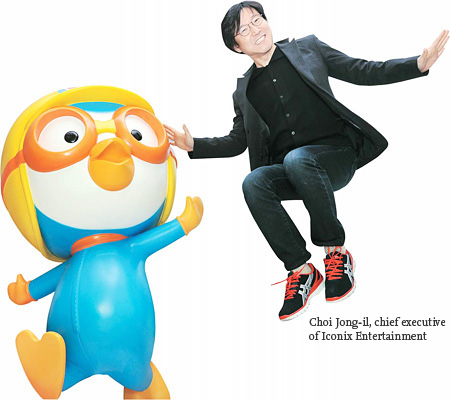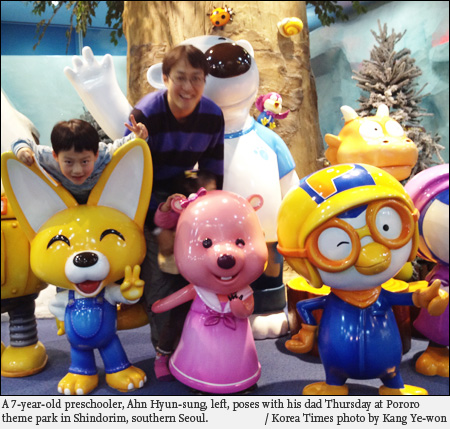
Pororo aims to be world’s beloved icon
 Strategic marketing grabs global children
Strategic marketing grabs global children
Standing next to a Pororo statue, Ahn Ye-eun, 4, was jumping nonstop with excitement at a Pororo-themed park in Shindorim, southern Seoul.
“She’s been speechless ever since she got here, she’s probably thinking she’s dreaming now,” said Yoo Jung-ran, 60, a grandmother who babysits Ahn and her brother, Hyun-sung, 7. That’s what happens when a family makes a trip to the newly opened amusement park for toddlers and preschoolers. To the Ahn siblings and other children, Pororo, a cartoon penguin, is their ultimate hero as he’s nicknamed “Potongryong,” meaning “Pororo the president.” He is also called “Poneunim,” or “Pororo the god.”
Considering Pororo’s dominance in children’s lives, parents have become concerned and even demanding. Producers have received many requests, ranging from what the character should eat and how to play in episodes to what he can do for society. Last July, an anxious dad posted a petition online raising an objection that Pororo and his friends eat too much cake and cookies. Claiming that it had a bad influence over his son who’s been asking for specific kinds of bread that Pororo eats, the dad suggested the cartoon show the penguin eating healthy Korean food such as rice, kimchi and stew. Within three months, nearly 4,500 of other parents, possibly with similar worries, signed the plea.
“Since 2011, we received a lot of feedback and attention, more than we would ever expected and we’ve been keeping social responsibility in mind when making new episodes,” said chief executive of Iconix Entertainment Choi Jong-il, in an interview with Business Focus.
Besides the recommendation on diet, some people suggested problem-solving story plots such as Pororo getting lost in the streets or encountering bullies, Choi said. Others have called for the character to become the mascot of the 2018 Winter Olympics to be held in Pyeongchang, Gangwon Province.
“As much as we would like to answer requests of Korean fans by reflecting more familiar Korean culture, we also have to make sure foreign viewers don’t feel alienated.” Choi added that the producers are preparing a special episode that features Korean dining.
What is it about Pororo?
It’s not just the cute look of the 3-D character — a blue and white, petite penguin sporting an aviator helmet and goggles — that appeals to children.
Compared to Choi’s previous animation creations including Michel, Chiro and friends, and Taegeuk Adventure, among others, which mostly targeted children in elementary school age, Pororo lowered the range to 2 to 6. The hard-core fan base goes even younger, under 2 to up to 4, Choi said.
“It was a strategic decision to target that young age group because I learned that was the weak spot of Japanese animation markets,” Choi said.
Pororo is an adventurous 5-year-old penguin, who dreams of flying, and lives on a snowy island with six other animal friends — Poby the polar bear, Eddy the red fox, Loopy the beaver, Crong the baby dinosaur, Petty the penguin and Harry the bird — all in same age range as Pororo except for Crong, who is 1.
Choi explained he carefully chose a “neutral” area for the cartoon’s background, so that children around the world can use their own imagination.
In fact, every detailed characteristic and move of Pororo and playmates were carefully designed and choreographed by Choi with a determination to make him one of world’s most beloved animation characters. His role models included Mickey Mouse, the Walt Disney icon who turned 84 this year, and the Japan’s most adored character, Hello Kitty, who has been cherished for nearly 40 years.
“We had three criteria when creating Pororo and the other characters: they should have a global appeal, a simple design for merchandising purposes and there should be no cultural reference in the stories,” Choi said.
The creators cautiously picked the colors — blue, pink and white — that are familiar to children and also ones that represent both genders. They consciously removed a pig from the character list, because it is a taboo in Islamic culture.
When making episodes, producers paid attention to details that could be biased to certain cultural codes or give a historical reference that is sensitive to viewers in certain parts of the world. For example, they make sure Pororo and friends wave hands instead of bow or even nod to each other. And there was an episode, which featured a space shuttle that resembled Columbia, a NASA spacecraft, which exploded in 2003 killing all seven astronauts onboard. It was removed from airing in the U.S.
Another success factor was that the cartoon is not about learning ABCs, usually what Korean moms expect their babies to do in advance to prepare for the highly competitive education system. Rather, Pororo plays with his friends in every episode, which is what 1- or 2-year-olds do in real life.
“The successful animation characters often have been super heroes, or princes and princesses, but Pororo is far from those models: he’s not perfect, he gets into trouble, but kids easily relate to him by watching him solve problems in his own way and having fun with his friends,” Choi said.
“When I saw my daughter glued to the TV watching Pororo, I knew I did it right this time,” said Choi, whose son and daughter, now 14 and 11, both grew up with Pororo.
Throughout his 17-year career in animation with many missed shots, the 48-year-old Choi realized that in order to succeed in global markets, he first had to win over Japanese animation markets, Asia’s biggest with an estimated size of 229 billion yen or about $2.6 billion last year, according to an Anime News Network’s report. It used to be about 10 times larger than Korean markets, said Choi who started his own animation company in 2001, but the gap has been closed to six- to seven-fold now.
After careful market research of Japanese Anime, Choi aimed for preschool children and hit a home run.
Pororo has been sold to 120 countries with its market size reaching 520 billion won or about $460 million. It secured 1,600 merchandise items garnering 12 billion won a year from royalties. Almost any kid’s product has Pororo stamps on them ranging from diapers and chopsticks to cellphones and laptops.
“It will be a lie if a family with kids don’t have a Pororo product in their house,” said Kim Jung-hee, 32, a housewife with a 6-year-old daughter.
The Ahn family at the amusement park agreed that their house is filled with Pororo items from toys and books to kitchen apparel to bedroom decor, Yoo said.
“We started to stack Pororo stuff ever since Hyun-sung was 1 year old, now Ye-eun is taking them over.”
And the success with the business followed with media close-ups and frenzies, Choi said. Last July, Radio Free Asia reported that the U.S. would ban Pororo based on the trade restrictions due to it being animated in North Korea. Soon local media picked up on the story, saying Pororo was not welcome in America.
“Because of all the noise and speculation from the Korean media on the possible U.S. ban on Pororo, before we even had an investigation, we got a call from the American government, asking what is Pororo?” Choi said with a chuckle. “Obviously (the U.S. State Department) was not aware of Pororo until then, and it later clarified that it had nothing to do with its trade ban.”
From late 2002 to early 2005, a North Korean firm called Samcheonri took part of subcontracting jobs for Iconix working on the animation including modeling, texturing and rendering. At that time, the U.S. had trade sanctions against North Korea, thus anything made in the North had to get approved by the State Department. Because the cartoon was not part of North Korean exports, it was never on the ban list.
Around the same time, another rumor went viral about Iconix rejecting Walt Disney’s offer to buy Pororo for 1 trillion won. Soon Disney headquarters denied making the bid. Choi said it was an unofficial proposal from Disney Asia to one of producers of the show. Choi made a statement that he has no intention of selling.
Going global
The number one mission for Choi in maturing the Pororo brand is to focus on marketing.
“The reason behind Mickey Mouse and Hello Kitty lasting for decades is marketers constantly renewing the characters so they don’t become old and boring,” Choi said. Within the next five years, Iconix expects sales from the international markets of Pororo to take up half of its entire revenue. That’s why Choi is pushing hard to expand its Asian fan base including in China, Vietnam and Thailand. Iconix will open its first international Pororo-themed amusement park in Beijing early this year. It has three Pororo parks in Korea and plans to add seven more by the end of the year. <Korea Times/Kang Ye-won>



